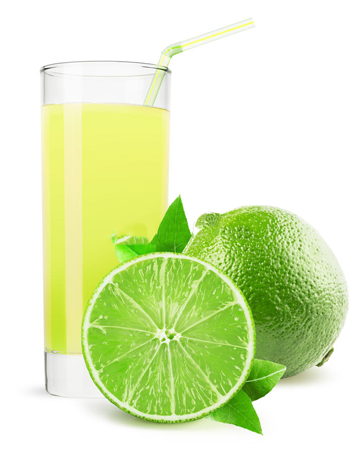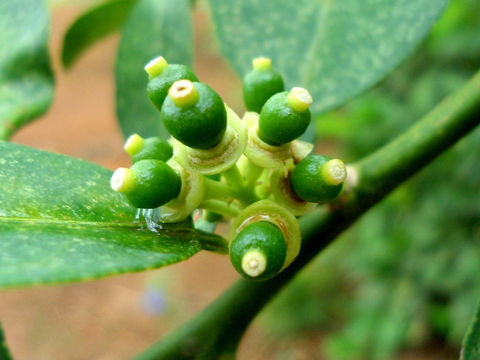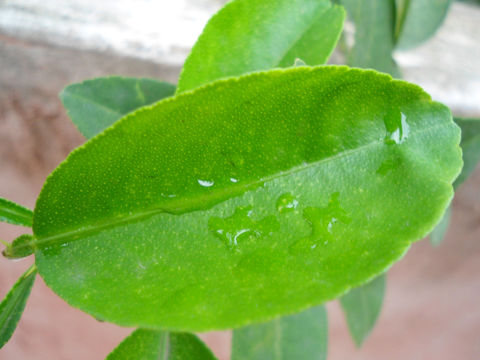Plant Description
Persian lime is a moderately vigorous, unarmed (thorn less) shrub or small tree that grows about 4.5 to 6.0 m (15 to 20 ft.) tall with widespread, drooping branches. Young shoots are purplish. In contrast to many other citrus species, it is often thorn less or nearly so. The plant is found growing in tropical climates, subtropical with winter rain such as in the Mediterranean and semitropical with summer rainfall. It prefers well drained, sandy or calcareous soils but will not withstand water-logged soils or heavy clays. Leaves are unifoliolate, alternate, broad- lanceolate, medium green, glabrous, pellucid dotted, with acute apex and acute base, and slightly crenulate margin. Flowers are axillary, white, fragrant, solitary or in a few flowered clusters. Flowers contain both the male and female organs of the plant; the male part produce pollen and the female part have the stigma or ovary.
Fruit
Flowers are followed by berry (hesperidium), oval, obovate, oblong or short-elliptical, usually rounded at the base that is 4 to 6.25 cm (1.5 to 2.5 in) wide and 5 to 7.25 cm (2 to 3 in) long, often with nippled or elongated ends, generally seedless or few-seeded. Fruits are initially vivid green to pale yellowish green and yellow when fully ripe. The fruit has thin, leathery skin dotted with oil glands. Pulp is pale greenish in 10 segments, tender and acid. The pollens are not viable. The fruit has a fragrant, spicy aroma and tart flavor, but the aroma and flavor are less intense than those of key lime. The advantages of the Persian lime in commercial agriculture compared to the key lime are the larger size, absence of seeds, hardiness, and absence of thorns on the bushes, and longer fruit shelf life that have combined to make it more widely cultivated. It is also widely available dried, as it is often used this way in Persian cooking. It is larger with less intense citrus aromatics than the key lime.
History
Citrus latifolia were first grown in southern Iraq and Iran, although other varieties were developed in the U.S. and Florida. Persian lime rose to fame after southern Florida’s key lime orchards were damaged by a hurricane in 1926. Mexico is now the main grower and exporter of Persian limes for the American, European and Asian markets. Mexico is the larger producer with a total of 1.9 million tons of limes in 2011. And they mainly distribute to 5 countries that are the largest importers of lime oil this are the US, UK, Japan, Belgium and Ireland. But in recent years Persian lime industry has taken off in Veracruz, dominated by large-scale producers, with over 25% of limes being produced using micro-jet irrigation or other irrigation systems, year-round in micro-climates.
Types
There have been only a few named cultivars, or alleged cultivars, of the Tahiti lime:
1. ‘Bearss’ (‘Bearss Seedless’, ‘Byrum Seedless’)
This was first put forward as a new variety of Tahiti lime originating in the grove of T.J. Bearss at Porterville, California, in 1895. It was described and illustrated in 1902 and cultivated and catalogued by the Fancher Creek Nursery Company in 1905. It was grown in California, Arizona and Hawaii under the name, ‘Bearss’, at least until the late 1940’s. However, comparative studies made in California led to the decision that the ‘Bearss’ did not differ sufficiently from the typical Tahiti lime to be maintained as a distinct cultivar.
2. Idemor
A limb sport found around 1934 in a grove owned by G.L. Polk in Homestead, Florida, and patented in 1941. The fruit is smaller and more round than the typical Tahiti. A very similar sport has been reported from Morocco. This lime is no longer planted because of its susceptibility to virus diseases.
3. Pond
In 1914, budwood was obtained by Dr. H.J. Webber from a Tahiti lime tree in the Moanalua Gardens, in Honolulu. Budded trees bore fruits that were somewhat smaller than the typical Tahiti but otherwise much the same. Trees were somewhat lower growing. This cultivar seems to have vanished.
4. USDA ‘No. 1’ and ‘No. 2’
Selections from many seedlings grown by Dr. James Childs of the United States Department of Agriculture at the Horticultural Field Station, Orlando, Florida. They are free of exocortis and xyloporosis viruses and are available to growers through Florida’s Budwood Registration Program. The fruit does not differ considerably in character from the typical Tahiti lime. The development of these virus-free clones has been a great boon to Florida’s lime industry.
Health benefits of Persian lime
The plants consist of food amount of Vitamin C and bioflavonoids and thus help to prevent cancer and fights cold. Listed below are few of the popular health benefits of consuming Persian lime
1. Heart health
Vitamin C is related to a reduced risk of dying from cardiovascular issues, though other nutrients common in fruit and vegetables, such as fiber content, are also thought to play a role. In a scientific research, lime juice and peel was shown to decrease fatty streaks found in coronary arteries. These streaks are actually indicators of plaque buildup and cardiovascular disease. Research concluded that low vitamin C levels are related with an increased risk of stroke. Thus include vitamin C rich Persian lime in your regular diet to get benefits.
2. Help prevent formation of kidney stones
Fresh or concentrate lime juice consists of more citric acid compared to orange or grapefruit juice. Citric acid is a natural inhibitor of kidney stones made of crystallized calcium. Go for fresh lime juice squeezed into water, as opposed to commercial limeades, for maximal benefits.
3. Healthy skin
Natural form of vitamin C, when consumed from fresh produce rather than in supplements, has a number of cosmetic benefits. It can help fight skin damage caused by the sun and pollution, reduce wrinkles, and improve the overall texture of the skin. Sufficient intake of vitamin C is also needed for building and maintaining the collagen that provides structure to skin and hair.
4. Boosting the immune system
Foods that are high in vitamin C and other antioxidants can help the immune system battle germs that cause a cold or flu. Vitamin C helps the immune system to produce more cells and also improves those cells’ ability to kill microbes and protect the body against disease.
Maintaining a diet high in fruits and vegetables is particularly important during the winter months. During this time, physical activity levels tend to decrease and seasonal diseases, such as the flu, gain momentum.
5. Digestion
Persian lime is a very common home remedy for digestive problems. Flavonoids present in lime help to stimulate the digestive system. Lime juice increases the secretion of digestive juices, which in turn encourages the peristaltic motion. Lime can also cure digestive problems like constipation, and helps in cleaning the excretory system. Rinds of lime consist of volatile oils which aid digestion and prevent stomach gases. Once digested, limes are said to have an alkalizing effect and help to treat peptic ulcers.
Traditional uses and benefits of Persian Lime
- Leaves or an infusion of the crushed leaves may be applied to relieve headache.
- Lime juice, administered quickly, was found to be an effective antidote for the painful oral irritation and inflammation that result from biting into aroids such as Dieffenbachia spp., Xanthosoma spp., Philodendron spp., and their allies.
- Lime juice has also been applied to relieve the effects of stinging corals.
- Excessive exposure to the peel oil of the Tahiti lime may cause dermatitis.
Ayurvedic health benefits of Persian lime Juice
- Indigestion & Acidity: A tsp of fresh lime juice mixed with a tsp of honey is a very effective home remedy for indigestion and burning in the chest due to acidity. Lime juice is also useful when there is excessive accumulation of saliva in the mouth.
- Hiccups: Take a tsp each of ginger juice, honey, lime juice and a pinch of pepper. Mix together and lick a tiny bit from a spoon.
- Earache: Dilute a few drops of fresh lime juice with equal quantity of water. Using 2 drops of this twice a day as ear drops is a very effective home remedy for earache.
- Constipation: Drinking a glass of fresh lime juice in warm water in the morning is a good home remedy for constipation.
- Colic or cramps in the abdomen: Mix a tsp of fresh ginger juice with a tsp of fresh lime juice and a pinch of rock salt and a little sugar. This mixture can be eaten by itself, or with a little warm water.
- Pimples: Grind a tsp of dried onion seeds with a little milk. Add half a tsp of fresh lime juice and apply it on the pimples. Leave overnight and wash off in the morning. This is a good home remedy for Acne.
- Anti- bacterial: A paste of fresh of tender leaves of lime with a pinch of turmeric makes an effective anti-bacterial face pack.
- Head Lice: To get rid of lice, mix garlic paste and fresh lime juice and apply at night to hair and wash off in the morning.
- Acidity of the skin: To a cup of unheated fresh milk, add a tsp of fresh lime juice and let it stand for a couple of hours. At bed time, wash your face well with water and pat dry. Apply the above mix and leave it on overnight and wash in the morning. Do this once a week for a few weeks. This ensures that the acidity of the skin is maintained at a healthy pH which dissuades bacterial growth.
- Bleeding piles: Halve a lime and apply rock salt powder on them. Keep this lime in your mouth and let the juice be taken in slowly. Lime juice has anti-hemorrhagic properties and rock salt which is rich in magnesium sulphate, checks bleeding, helps good bowel movements and slowly shrinks the pile masses.
- Swollen gums: A cup of diluted fresh lime juice mixed with a pinch of rock salt should be consumed. Lime rind can also be rubbed over the gums for relief.
Culinary Uses
- Fresh fruit is used as garnish for meats and drinks.
- Fruit is also processed into marmalade and candied peels.
- Fresh juice is used in beverages especially limeade, cordials, marinating fish and meats and seasoning many foods.
- Juice is frequently used as an alternative to vinegar in dressings and sauces.
- Frozen and canned juice is used in similar ways.
- Tahiti lime is a great accompaniment with avocado served in the form of wedges.
- It is utilized for enhancing lime juice and for most of the other purposes for which Mexican lime peel oil is employed.
- Flowers petals are edible.
- Juice is used as a substitute for vinegar.
Other facts
- Tahitian lime juice can be used a rinse after shampooing the hair or used as a fresh face lotion.
- Juice can be used for cleaning the inside of coffee pots and tea kettles.
- Diluted lime juice will dissolve calcium deposits overnight.
- Whole lime can be grind in the electric garbage-disposal to eliminate unpleasant odor.
- Lime juice has been applied on the face as a freshening lotion.
- Dilute lime juice will dissolve, overnight, calcium deposits in teakettles.
- Some Florida housewives use lime juice for cleaning the inside of coffeepots, and grind a whole lime in the electric garbage-disposal to eliminate unpleasant odor.
- Persian Lime trees grow at a rate of 13 to 24 inches each year from the seedling stage.
Precautions
- Wash the peels of limes even if you are not planning on using them. Bacteria from the peel can transfer to the inside of the fruit during the process of cutting via the knife.
- When zesting a lime, use organic limes if possible.
- Sap of the tree and scratches by the thorns may cause rash in sensitive individuals.
- Excessive exposure to the essential oil in the peel of the fruit may cause dermatitis.
Recipe
Persian Lime Pie
Ingredients for one 9-inch pie
- 3 eggs yolks, at room-temperature
- 1 14-oz can sweetened condensed milk
- The zest and juice of 3 Persian limes
- 1 Pate Brisee Sucree crust, pre-baked in a 9-inch removable-bottom tart pan
- 1 cup heavy cream
- 2 tablespoons sugar
Directions
- Preheat oven to 350°F, with the rack at the center position
- Using an electric hand-held mixer or a standing mixer outfitted with the whisk attachment, beat the egg yolks at medium speed until pale and thick — about 2 minutes. Then, with the mixer running, beat in the condensed milk, followed by the lime juice and zest. Pour the custard into the pre-baked pastry shell.
- Bake until the filling is set (it shouldn’t jiggle if bumped) — about 15 minutes.
- Transfer the pie to a wire rack to cool. When completely cool, refrigerate for at least 2 hours. (The pie can be wrapped in plastic, and refrigerated for up to 2 days.)
- To decorate, beat the cream and sugar until thick and firm. Scoop the cream into a pastry bag outfitted with a star tip.
- Place a slice of lime in the center of the pie, piping little stars between the round of lime and the crust.
References:
https://davesgarden.com/guides/pf/go/54415/
https://en.wikipedia.org/wiki/Persian_lime
https://www.hort.purdue.edu/newcrop/morton/tahiti_lime.html
https://www.cabi.org/isc/datasheet/13448
Comments
| Persian Lime Quick Facts | |
|---|---|
| Name: | Persian Lime |
| Scientific Name: | Citrus latifolia |
| Origin | Southern Iraq and Iran |
| Colors | Vivid green to pale yellowish green and yellow when fully ripe |
| Shapes | Berry, oval, obovate, oblong or short-elliptical, usually rounded at the base and apex with papilla, 4 to 6.25 cm (1.5 to 2.5 in) wide and 5 to 7.25 cm (2 to 3 in) long |
| Flesh colors | Light green to yellow |
| Taste | Sweet, sour |
| Health benefits | Good for Digestion, Boost immune system, Healthy skin, Help prevent formation of kidney stones, Heart health |
| Name | Persian Lime |
|---|---|
| Scientific Name | Citrus latifolia |
| Native | Southern Iraq and Iran, although other varieties were developed in the U.S. and Florida |
| Common Names | Bearss Lime, Persian Lime, Seedless Lime, Tahiti Lime, Tahitian Lime, Persische Limette, Tahitilimette, lima da Persia |
| Name in Other Languages | Chinese: Kuan ye lai mu (宽 叶来母) English: Tahiti lime, Seedless lime, Persian lime, Bearss lime Finnish: Persian limetti French: Lime de Perse, Lime de Tahiti, Limettier de Tahiti, Limettier, Limettier De Perse, limettier tahiti German: Persische Limette, Tahitilimette, Tahiti-Limonelle, Tahiti-Limonellenbaum Italian: Limetta di Tahiti Japanese: Tahichi raimu (タ ヒチライム) Portuguese: Limeira Bearss Spanish: Lima común da Persia, Limero de Tahiti, Lima De Persia, Lima Tahiti Vietnamese: Chanh Ba Tư, Chanh không hạt, Chanh Tahiti |
| Plant Growth Habit | Moderately vigorous, unarmed (thorn less) shrub or small tree |
| Growing Climates | Found growing in tropical climates, subtropical with winter rain such as in the Mediterranean and semitropical with summer rainfall |
| Soil | Well drained, sandy or calcareous soils but will not withstand water-logged soils or heavy clays. |
| Plant Size | 4.5 to 6.0 m tall (15 to 20 ft.) |
| Leaf | Unifoliolate, alternate, broad- lanceolate, medium green, glabrous, pellucid dotted, with acute apex and acute base, and slightly crenulate margin |
| Flower | Axillary, white, fragrant, solitary or in a few flowered clusters. Flowers contain both the male and female organs of the plant; the male part produce pollen and the female part has the stigma or ovary |
| Fruit Shape & Size | Berry (hesperidium), oval, obovate, oblong or short-elliptical, usually rounded at the base and apex with papilla, 4 to 6.25 cm (1.5 to 2.5 in) wide and 5 to 7.25 cm (2 to 3 in) long |
| Fruit Color | Vivid green to pale yellowish green and yellow when fully ripe |
| Fruit skin | Thin, leathery and dotted with oil glands |
| Flesh Color | Light green to yellow in 10 segments, tender and acid |
| Pollinators |
|
| Flavor/aroma | Fragrant, spicy aroma |
| Taste | Sweet, sour |
| Plant Parts Used | Fruit |
| Season | May–June and November–December |
| Propagation | By Seed |
| Varieties |
|
| Health benefits |
|


















